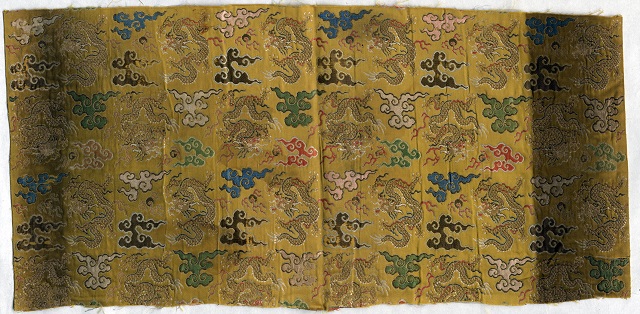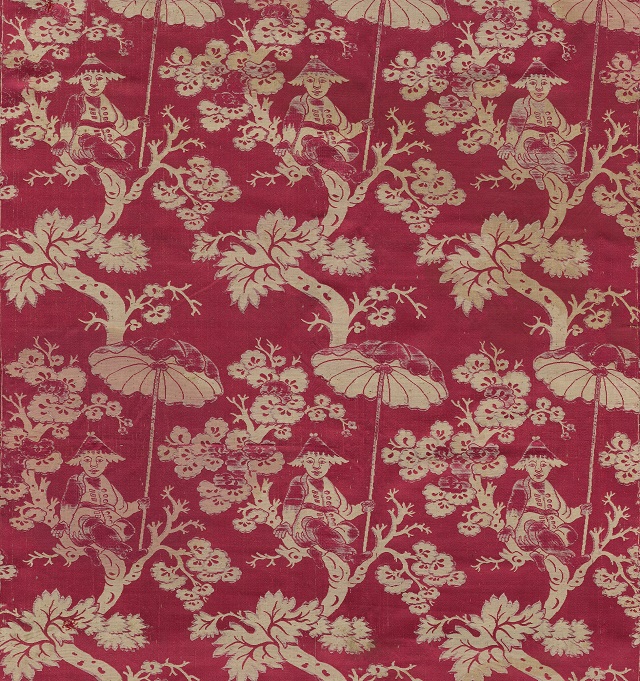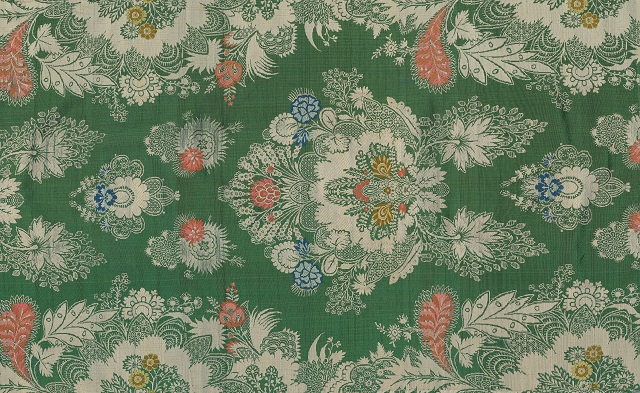展览地点:纺织品文物修复展示馆二楼
展览时间:2019年5月17日 - 2019年8月4日
前言
欧亚大陆贯穿联通,早在青铜时代就有文化和技术的传播和交流。从17世纪末至20世纪初,欧洲与亚洲的交流更为密切,其中纺织品的贸易往来尤其频繁。染料,是纺织品色彩的主要来源,能够反映当时各个地区的流行颜色,生产工艺以及相互的交流情况。本次展览将通过文物实物的展示,并根据纺织品染料的检测结果,阐述300年欧亚染料的各自特色和共同点,为纺织科技全球史提供实证。
欧亚染料种类繁多,大致可以分为动物染料和植物染料两种,往往使用明矾、黑矾等矿物作为媒染助剂。动物染料多从昆虫中提取色素,如胭脂虫、紫胶虫在酸性条件下上染纤维可获得不同色调的红紫色;五倍子、没食子可以与黑矾媒染得到灰黑色。植物染料是天然染料的重要组成部分,各地染匠在生产过程中结合当地植被情况不断选取各种植物色素浓郁的部分作为染料使用。如苏木的芯材、茜草的根、槐树的花蕾、核桃的果皮等。除了借助媒染剂和各种如草木灰、乌梅等酸碱性助剂染得更丰富的颜色之外,各地染匠还结合各植物染料本身的特性,相互套色形成各种色调的紫色、绿色、褐色等间色。300年的欧亚染色史不仅仅映射了欧亚大陆精湛的纺织印染工艺,也是历代染织匠人的劳动智慧的凝结。
Preface
It’s as early as the Bronze Age that Europe and Asia had cultural and technical exchanges, which became more frequent from the end of the 17th century to the beginning of the 20th century. And trade in textiles was obviously prosperous during that time. Dyes, which can reflect popular colors of various regions and mutual exchanges in production techniques, are main sources of textiles’ colors. The exhibition will illustrate features and similarities of European and Asian dyes through displaying historical relics and unveiling the results of dye identification, providing some evidences for the global history of textile technology.
There are various kinds of dyes in Europe and Asia, which can be roughly divided into animal dyes and plant dyes. Minerals, such as alum and iron, are mostly used as mordant. Most animal dyes are obtained from insects by extracting pigments in them. For instance, cochineal and lac can be used as mordant dyes with the carbonyl and the adjacent phenol groups participating in the fiber–mordant–dye complex to get different shades red and purple; gray and black can be got by dyeing galls of different sumac species with iron. As an essential part of natural dye, plant dyes have always been a priority for dyers who, in the light of local realities, will use the part with strong pigment of a plant as dyes when dyeing, such as cores, trunks, rhizomes of trees, sappanwood, madder, safflower, buds of pagoda tree, peels of pomegranate and walnut. Dyers, for the sake of abundant colors, will not only use mordant and various acidic and alkaline additives to help, including dark plum and lye , but over-dye according to characteristics of plant dyes to get secondary colors like purple, green and brown with various shades. The 300-year dyeing history of Europe and Asia shows both superb dyeing and weaving techniques and wisdom of dyers and weavers in our history.
版块1:欧洲的荣耀
Part 1 The Glorious Europe
16世纪中后期,西班牙人在南美发现当地广泛使用美洲胭脂虫,带回到欧洲,很快代替了欧洲本地产的克玫兹胭脂虫。此外,来自锡兰的苏木和印度的木蓝都在17世纪前后输入欧洲。
In the mid-late 16th Century, the Spaniard discovered that American cochineal was widely used in South America as a mordant dye. Then, it was introduced to Europe, quickly replacing the native kermes. Besides, Sappanwood, native to Ceylon, and Indigo, indigenous to India had been imported into Europe around the 17th century as well.
红色织锦中国风
编号:2016.18.24
法国,191cmx72cm
染料来源:克玫兹胭脂虫( 红色),紫胶虫(绛色)
克玫兹胭脂虫(Kermes vermilio)生长在胭脂虫栎上,产地分布于法国、西班牙、摩洛哥、土耳其、黎巴嫩等地中海沿岸。该介壳虫染料的主要色素为胭脂酮酸。另一种胭脂虫(Dactylopius spp.)则更为人们熟知,原产地为中南美洲。目前,秘鲁和墨西哥的不少村庄都还饲养这种生长在仙人掌上的昆虫,其主要色素为胭脂虫酸。
The Kermes (kermes vermilio) grows on kermes oak (Quercus coccifera) and originates from the Mediterranean, including France, Spain, Morocco, Turkey and Lebanon. The main component of the scale insect dye is kermesic acid. Another branch of the Coccidea family that people are more familiar with is Dactylopius spp., indigenous to Central and South America. At present, there are still some villagers in Peru and Mexico feeding such insects living in cactus of the Opuntia family. This product consists predominately of carminic acid.
16世纪,由于在海外贸易中的活跃,英国和荷兰不仅是重要的金融中心,也是欧洲的染色工业中心。路易十四登上皇位后,他的辅佐大臣致力于发展法国经济,其中第一个扶植的就是纺织业,颁布的章程中规定羊毛染色必须使用的染料品种。
17世纪初,欧洲广泛使用的染料有胭脂虫、茜草、苏木,黄色的主要是木犀草,姜黄往往用作打底。紫色除了用蓝、红染料套染,也会用到地衣紫。
Due to prosperous overseas trade, England and Holland were developed into both important financial centers and European centers of the dyeing industry in the 16th century. After Louis XIV ascended the throne, his chief minister dedicated to developing economy. The textile industry was given a priority and issued regulations stipulated that dyeing wool must use some certain of dyes.
At the beginning of the 17th century, the widely used dyes in Europe were mainly obtained from American cochineal, madder and sappanwood. One of the main flavonoid yellow dye sources is weld. And turmeric, was often used as a direct dye, mainly in combination with other dyes. In addition to over-dyeing with blue and red dyes, lichen dyes would also be used to gain purple.
荷兰绿地妆花织物
编号:2016.18.31
荷兰,94cmx39cm
染料来源:苏木(红色),红花(红色),木犀草(黄色),靛青(蓝色)
木犀草(Reseda luteola)生长于西南欧,地中海沿岸以及北非,既有野生也有人工种植。该染料是欧洲17-20世纪使用最广泛的黄色染料,其主要色素为木犀草素、芹菜素及相应的葡萄糖苷。
苏木(Caesalpinia sappan)和红花(Carthamus tinctorius)都是外来的植物染料,前者原产于东南亚,后者可能起源于埃及。苏木经明矾媒染得到木红色。红花染色过程复杂,需要去除红花黄色素后才能获得含量极少的红花素(carthamin),但由于其颜色明艳纯正获得欧亚各国染匠的喜爱,从7世纪开始,至19世纪末一直广泛地用作染各种色度的红色。
天然染料中有两类来自于海洋的生物,骨螺和地衣。骨螺可染紫色,其染色工艺非常复杂,且价格昂贵。地衣(Roccella spp)也用来染紫色,生长于地中海和大西洋沿岸的岩石峭壁上,属于真菌类生物。早在公元前就有地衣染色的记载,碱性条件下得到蓝紫色,酸性条件下得到紫红色。
Weld (Reseda luteola), wild but also cultivated, grows in Southwestern Europe, the Mediterranean and North Africa. It was the most-used yellow dye from the 17th to 20th century, with main components of luteolin, apigenin and relative glucosides.
For Europe, both sappanwood (Caesalpinia sappan) and safflower (Carthamus tinctorius) were the exotic plant dyes. The former is native to Southeast Asia and the latter probably Egypt. Dyeing with alum, sappanwood can produce wood red. The dyeing process of safflower is highly complicated and little carthamin can be obtained after removing yellow pigments. However, the pure and bright hue of carthamin was so charming that dyers of Europe and Asia could not help falling in love with it. As a result, it had been widely used to color red with various shades from the beginning of the 17th century to the end of the 19th century. There are two kinds of maritime creatures used as natural dyes, molluscs and lichens. With complicated dyeing process and high costs, different shades of purple can be obtained from molluscus. Lichens, fungus organisms growing in rocky cliffs of the Mediterranean and the Atlantic coast, can be used to produce orchil or archil dyes they were obtained. The record of dyeing with lichens can be dated back to 2,000 years ago. Using lichens, blue purple will be produced amid alkaline conditions, while red purple be obtained within acidic conditions.
18世纪是科学探索的时代,基于牛顿色彩理论的建立,无论是化学家,还是染匠都对染料科学感兴趣。同时期,珍妮纺纱机的发明使人们对丰富色彩的需求更大。第一个半合成染料酸性靛蓝在1740年出现,随后合成的硫酸铝代替了明矾,100年后,苯胺紫的发明使天然染料的市场逐渐崩塌。
As 18th century was an age of scientific exploration, chemists and dyers had great interests in dye science which included in Newton's Color Theory. At the same period, people had an even larger demand of colors after the invention of the Spinning Jenny. Indigo carmine, as the first semi-synthetic dye came out in 1740, later synthetic aluminum sulfate took the place of alum. One hundred years after that, the invention of mauveine ended up the market of natural dyes.
版块2:亚洲的传统
Part 2 Asian traditions
尽管欧洲分布的国家很多,但各自染料的品种较为相似。而在亚洲,不同地域的染料使用品种各具特色。
中亚染料以伊朗(波斯)染料为代表,拥有享誉世界的特产——地毯,该产业的兴衰从侧面可以看到染料的使用情况。萨菲皇朝(16-18世纪中期)是波斯人统治的伊朗,是一个织毯盛行的时代。精美的图案和绚丽的色彩需要高品质的染料。随后由于战争,关于地毯的记载较少。直到18世纪末,卡扎尔皇朝的建立,织毯业才逐渐恢复。300年来,伊朗染匠使用的红色染料有茜草,黄色的是黄花飞燕草,黑色的石榴皮和没食子,另外来自印度的紫胶虫和木蓝也常常用作染色。
南亚的印度历史非常悠久,但遗憾地是极少有16世纪之前的纺织品保存下来。值得庆幸的是,由于印度对手工业的保护,直到今天,仍然能够看到有近20种天然染料在各地的村庄染坊被使用。东南亚的印染受到印度和中国的影响,又具有当地民族特色。
Although there are many countries in Europe, the types of their dyestuffs are similar. Whilst dyestuffs in Asia have unique and distinctive features vary with areas.
Iran’s dyestuffs represented Central Asian dyestuffs and its carpet is a world famous specialty. And the rise and fall of the carpet industry also indicated the development of dyes. The Safavid Dynasty (Mid-16th to Mid-18th centuries) was an era of carpet-weaving when Iran was ruled by Persians. Dyes of high quality are required for fine patterns and brilliant colors. Subsequently, records on carpets are even less due to the war. It was not until the late 18th century, with the establishment of the Qājār Dynasty, that the carpet industry was gradually restored. For 300 years, Iranian dyers have been using madder as red dye, larkspur as yellow dye, pomegranate peels and sumac galls as black dyes, Lac and indigo (Indigofera tinctoria) from India were also used for dyeing Iranian textiles.
India is a country in South Asia with pretty long history, but unfortunately very few pre-16th century textiles reserve. At the same time, thanks to the protection of Indian handicraft industries, nearly 20 kinds of natural dyes today are being used in village dyehouses all over the country so far as we know. The textile printing industry in southeast Asia is influenced by India and China with local characteristics.
典礼仪式用船布
编号:2014.61.15
印度尼西亚,232cmx56cm
染料来源:海巴戟天(红色),姜黄(黄色),靛青(蓝色)
黄花飞燕草(Delphinium semibarbatum)是伊朗、阿富汗和北印度特有的黄色染料植物。关于它的历史记载不多,中国新疆地区曾出土回鹘时期该植物染色的缂丝长袍。
海巴戟天(Morinda citrifolia)是东南亚典型的红色染料,其主要成分为蒽醌类化合物巴戟醌。
17-19世纪,东南亚、中南半岛和中国南部使用范围最广的黄色染料是姜黄(Curcuma longa),该染料易于着色,但光照牢度欠佳。其主要色素成分为姜黄素及其两种衍生物。
Larkspur (Delphinium semibarbatum), which is used for making yellow dyestuff is unique in Iran, Afghanistan and north India. There are few historical records about it. The Kesi robe dyed with larkspur in the Uighur period was unearthed in Xinjiang, China.
Indian mulberry (Morinda citrifolia) is a typical red dyestuff in southeast Asia. Its main component is an anthraquinone compound, morinone. In the 17th and 19th centuries, Turmeric (Curcuma longa) was the most widely used yellow dyestuff in Southeast Asia, Indochina and Southern China. The dyestuff is easy to tint but has low light fastness. The main components are curcumin and its two derivatives.
东亚以中国为代表,17世纪至20世纪处于中国最后一个封建王朝——清朝。清朝的统治者沿袭明朝的制度,纺织印染技术也是对前朝的传承。明朝的《天工开物》介绍了当时的染料品种和染色方法,清代的《布经》反映了江浙一带染布的秘诀和配方。特别重要的历史文献是清代宫廷内务府织染局的销算档案,不仅有色彩名称,而且还记载了染料助剂的配比。无论是染丝还是染布都集中在江南地区。日本和朝鲜半岛的印染技术与中国有相同的地方,17世纪之前,中国的染料和染色方法就输入了这两个地区。
In regard to characteristic dyestuffs, East Asia takes China for its represent. The Qing Dynasty, which is the last feudal dynasty in China from the 17th century to the 20th century, follows the etiquette system and the textile printing and dyeing technology of the Ming Dynasty. Tiangong Kaiwu (Exploitation of Products from the Nature by Combination of Artificial Skills and Natural Power), written by Song Yingsing in Ming Dynasty, introduces the dye varieties and dyeing methods at that time; The Book of Cloth, which was written in Qing Dynasty, shows the methods and formula of dyeing cloth in Jiangsu and Zhejiang provinces. The record of the Textile and Dyeing Department of Nei WU Fu in Qing Dynasty, which is an important historic reference, not only records the names of colors, but also records dyeing recipes. Both the silk and cloth dyeing industries are concentrated in the south of the Yangtze River. The printing and dyeing technology in Japan and the Korean Peninsula is similar to that in China as China’s dyes and dyeing methods were introduced to these regions before 17th century.

明黄地五彩云龙妆花缎
编号:0289
中国,85cmx42.5cm
染料来源:红花(红色),苏木(红色),靛青(蓝色),黄檗(黄色),槐米(黄色),姜黄(黄色)
到了清代(1616-1912),用于服饰染色的染料品种主要有十余种,使用频率较高的为红花、苏木、槐米、黄檗、姜黄、靛青、五倍子和橡碗子。其中,具有东亚特色的植物染料是槐米和黄檗。
槐米是槐树(Sophora japonica)未开放的花蕾,富含芦丁,可以染得明艳的黄色,是明清两代染黄色的主要植物染料。黄檗(Phellodendron amurense)是小檗碱类植物,无论是中国还是日本均用作染黄色。另外,黄檗打底色与红花套染能够节约红色素的消耗而染得红色。
By the Qing Dynasty (1616-1912), there were more than ten kinds of dyes used to dye textiles. The most frequently used dyes were safflower, sappanwood, bud of pagoda tree, amur cork, turmeric, indigo, gallnut and top of oak tree fruit. Among them, pagoda tree and amur cork are special East Asian plant dyestuffs.
Bud of pagoda tree is the main vegetable dyestuff in Ming and Qing dynasties as it is rich in rutin so that it can produce bright yellow. Amur cork (Phellodendron amurense) is a berberine-based plant, producing yellow. In addition, using amur cork as the base and over-dyeing with safflower can produce red while consuming less carthamin.

石青缎绣团鹤料
编号:0302
中国,30cmx22cm
染料来源:苏木(红色),靛青(蓝色),黄檗(黄色),姜黄(黄色),黄荆(黄色)
单宁和靛青
含单宁的植物或昆虫虫瘿可以染黑色,欧亚染匠常使用盐肤木(Rhus spp)的树皮或叶子,以及寄生的五倍子与铁媒染得到黑色,也使用栎树(Quercus spp)果实的壳斗。中亚地区则使用当地的特产石榴皮(Punica granatum)和核桃皮(Juglans regia)染黑色。由于大多数黑色染料均为单宁类,吸附在织物纤维后形成鞣花酸,故很难鉴别黑色染料的来源。同样的难题也出现在靛青植物来源的区分,所有含靛植物形成靛青后都只存在两种主要色素靛蓝和靛玉红。欧洲本地的含靛植物是菘蓝(Isatis tinctoria),东亚使用的是蓼蓝(Polygonum tinctorium),而东南亚和南亚盛产木蓝(Indigofera tinctoria)和马蓝(strobilanthes cusia)。由于四种蓝草中,木蓝和马蓝中色素的含量较高,18世纪以后,欧洲和亚洲普遍使用这两种植物制靛染蓝。因此,17世纪至20世纪初,印度成为世界上出口靛青最多的国家。
Tannin and Indigo
Tannin-type dyes were mainly used to produce blacks on textiles all over the world in the past, for example, various species of oak trees (Quercus spp) have been widely applied to dyeing and producing black with iron from the 17th century to the end of 19th century. In addition to oak, European and Asian dyers dyed black with sumac, not only barks and leaves (e.g. Rhus coriaria) but also galls (e.g. Rhus chinensis) of these plants contain abundant of tannin. In Central Asia, the dyers would use local specialties such as pomegranate (Punica granatum) and walnut (Juglans regia) to produce black. It is quite difficult to identify plant sources of the black dyes as most of them contain mainly tannins and they would form ellagic acid after adsorbing on fabric fibers in most cases. The similar problem also arises when distinguish the different species of indigo-based plants, such as Isatis tinctoria (Europe), Polygonum tinctorium (East Asia), Indigofera tinctoria (Southeast Asia) and strobilanthes cusia (South Asia) as extracts of all indigo dyed textiles have indigotin and indirubin as the major components. Among these four plants, Indigofera tinctoria and strobilanthes cusia contain high content of indigoids, so they were widely used after the 18th century. Therefore, India became the largest exporter of indigo in the world during the 17th century to the early 20th century.
结语
本次展览通过文物的展示和染料的鉴别回顾了300年欧洲与亚洲染料使用的历史,基本呈现了欧亚大陆各个地区常见的典型染料。通过染料地图,我们可以发现有些染料具有明显的区域性,比如地衣紫、黄花飞燕草;有些染料的使用横贯东西,比如苏木、红花;还有些染料的植物来源不同,但最终附着于织物上均是同一类色素,比如单宁和靛青。
早在上个世纪中期,合成染料已经在纺织工业市场取代了天然染料,天然染料的时代不可再回。然而,今天的人们在社会生活中对于自然、生态、和谐的追求却越来越强烈,天然染料在一定范围内的应用正是这种追求的体现。
Conclusion
Through the presentation and identification of cultural relics, the exhibition gives a review of 300 years history of use of dyestuffs in Asia and Europe, presenting typical dyes which were often seen in different regions of Eurasia. According to the dye distribution map, we can clear see that some dyes such as the orchil and larkspur have distinctive regional characteristics; some are widely used in the East and the West like sappanwood and safflower; some have different origins but eventually adsorbing on the fabric and being the same pigments like tannin and indigo. As early as the middle of last century, the natural dyes have been replaced by the synthetic dyes in the textile industry. The era of using natural dyes was gone. However, nowadays people have stronger eager for a natural, ecological and harmony life, while the appropriate application of the natural dyes exactly meets that eager.





 关注我们
×
关注我们
×